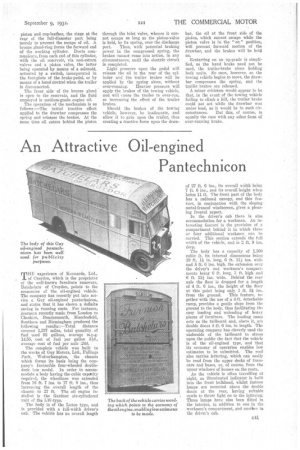An Attractive Oil-engined Pantechnicon
Page 63

If you've noticed an error in this article please click here to report it so we can fix it.
THE experience of Kennards, Ltd., of Croydon, which is the proprietor of the well-known furniture removers, Batchelars of Croydon, points to the economies of the oil-engined vehicle. The company has recently put into service a Guy oil-engined pantechnicon, and states that it has shown a definite saving in running costs. For instance, journeys recently made from London to Cheshire, Bournemouth, Macclesfield, Southsea and Birmingham produced the
following results :---Total distance covered 1,337 miles, total quantity, of fuel used 92 gallons, average m.p.g. 14.55, cost of fuel per gallon 3*d., average cost of fuel per mile .24d.
The complete vehicle was built in the works of Guy Motors, Ltd., Fallings _Park, Wolverhampton, the chassis which forms its basis being the cornrally's Invincible four-wheeled doubledeck bus model. In order to accommodate a body having the cubic captivity required, the wheelbase was extended from 16 ft. 7 ins. to 17 ft. 8 ins., thus increasing the overall length of the chassis to 27 ft. The oil engine installed is the Gardner six-cylindered unit of the LW-type.
The body is of the Luton type, and is provided with a full-width driver's cab. The vehicle has an overall length
of 27 ft. 6 ins., its overall width being 7 ft. 6 ins., and its overall height when laden 11 ft. The front part of the body has a radiused canopy, and this feature, in conjunction with the sloping metal-framed windscreen, gives a pleasing frontal aspect.
In the driver's cab there is also accommodation for a workman. An interesting featureis the provision of a compartment behind it in which three or four additional workmen can be _carried. This section extends the full width of the vehicle, and is 2 ft. 9 ins. deep.
The body has a capacity of 1,300 cubic ft. its internal dimensions being 19 ft. 1.* in. long, 6 ft. 111 ins, wide and .8 ft. 6 ins, high, the extension over the driver's and workmen's compartments being 6 ft. long, 3 ft. high and 6 ft. 11-i ins. wide. Behind the rear axle the floor is dropped for a length of 4 ft. 6 ins.' the height of the floor at this point being only 1 ft. 3* ins.
from the ground. This feature, together with the use of a 4-ft. detachable ramp, provides a gentle slope from the ground to the body, thus facilitating the easy loading and unloading of heavy pieces of furniture. The loading ramp acts as the tailboard and, above it, are double doors 4 ft. 6 ins, in length. The operating company has cleverly used the underside of the tailboard to stress upon the public the fact that the vehicle is of the oil-engined type, and that its economy of operation enables low estimates to be submitted. The roof also carries lettering, which can easily be read from the upper decks of tramcars and buses, or, of course, from the upper windows of houses on the route.
As the vehicle is often travelling at night, an illuminated indicator is built into the front bulkhead, whilst festoon lamps are mounted above the double doors at the rear, having suitable cowls to throw light an to the lettering. Three lamps have also been fitted in the interior, in addition to one in the workmen's compartment, and another in the driver's cab.












































































































